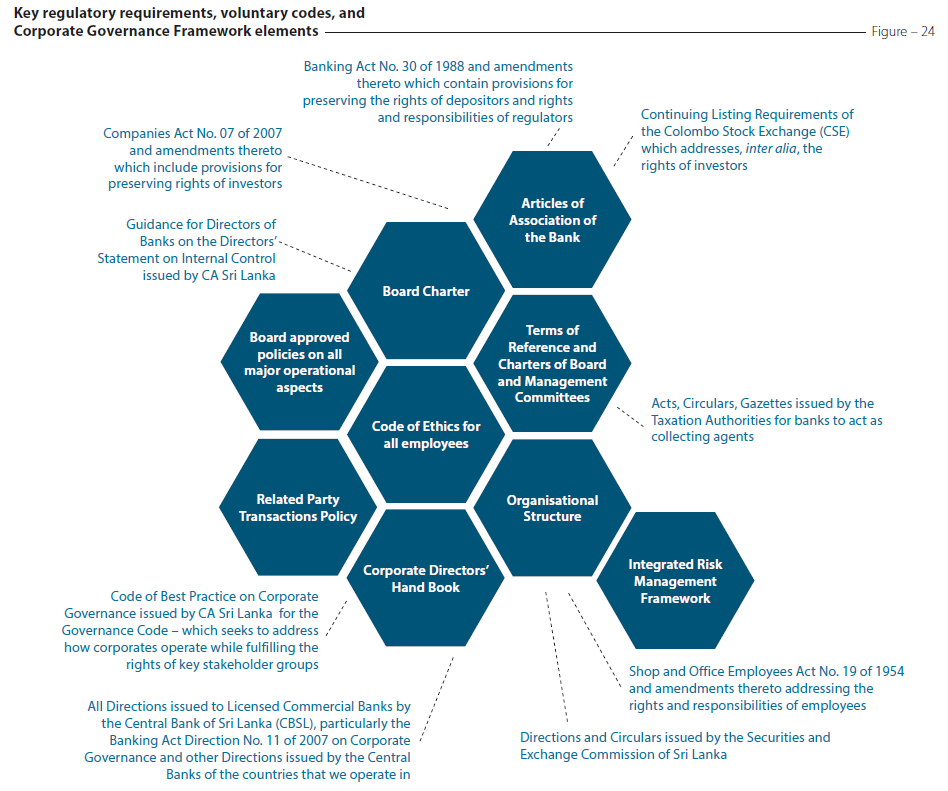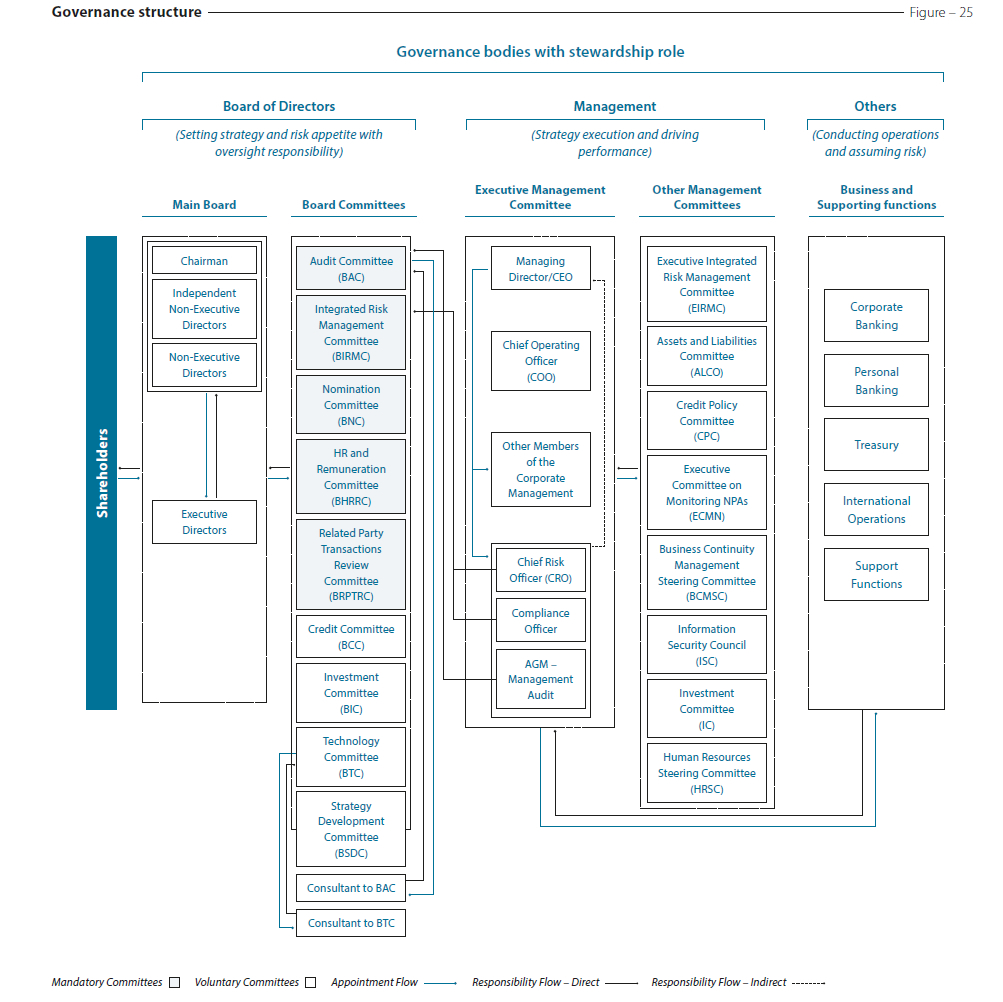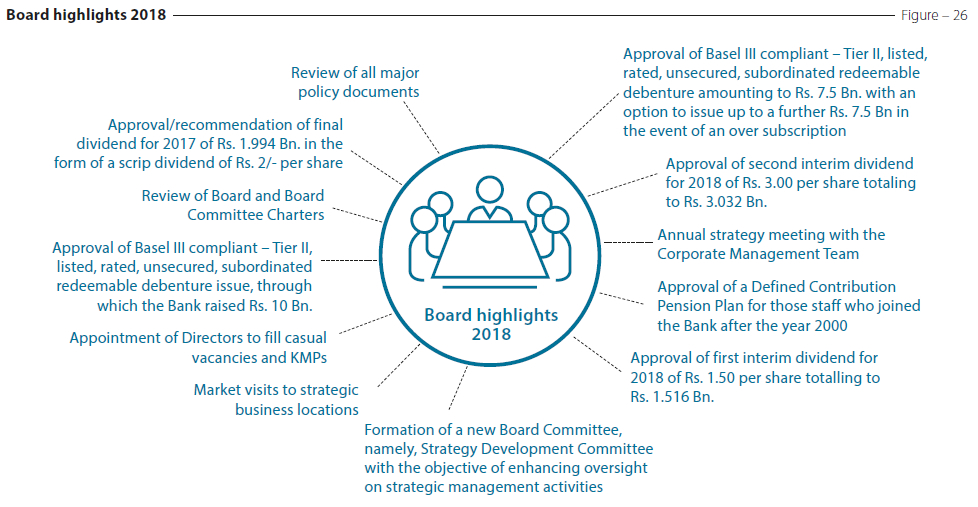The Remuneration and Benefits Policy seeks to provide a distinctive value proposition to current and prospective employees that attracts and retains people with capabilities and values in line with the business needs of the Bank. It also provides a framework for the employer to design, administer, and evaluate effective reward programmes, inspiring and motivating desired behaviours.
Directors’ and Executive remuneration
The BHRRC is responsible for making recommendations to the Board regarding the remuneration of Executive Directors. This vital committee comprises entirely of NEDs who also meet the criteria for independence as set out in the relevant regulations on corporate governance. They consult the Chairman and the CEO regarding the same and also seek professional advice whenever it is deemed necessary. Remuneration for NEDs is set by the Board as a whole. Remuneration for Executive Directors is set out with reference to the Remuneration and Benefit Policy. These processes ensure that no individual Director is involved in determining his or her own remuneration. The Board and the BHRRC engage the services of HR professionals on a regular basis to assist in the discharge of their duties in this regard.
The level and make up of remuneration
BHRRC is responsible to ensure that the remuneration of both Executive Directors and NEDs is sufficient to attract eminent professionals to the Board and retain them for driving the performance of the Bank. Bank has remuneration policies to determine remuneration and benefits of the Executive Directors and KMP which are attractive, motivating and capable of retaining high performing, qualified, and experienced employees at the Bank.
The total remuneration of KMPs includes three components – guaranteed remuneration (the fixed component), annual performance bonus (a variable component) and the ESOP (a variable component). Every effort is made to make the basis of granting ESOPs and their features transparent when approval is sought from the shareholders. Being employees of the Bank, the Executive Directors are also eligible for these ESOPs. The BHRRC structures the remuneration packages and benchmarks it with the market on a regular basis with the assistance of professionals to ensure that total remuneration levels remain competitive in order to attract and retain key talent whilst balancing the interests of the shareholders. The Bank’s two employee associations – the Association of Commercial Bank Executives and the Ceylon Bank Employees’ Union (CBEU) with whom a regular
dialogue is maintained – are also consulted when necessary.
Guaranteed remuneration comprises the monthly salary and allowances which is determined with due reference to the qualifications, experience, levels of competencies, skills, roles, and responsibilities of each employee. These are reviewed on an annual basis and adjusted for such factors as promotions, performance and inflation. The annual performance bonus is determined with reference to a multi-layered performance criteria matrix which is clearly communicated to the relevant categories of employees at the beginning of the year. Details of the ESOPs and the eligibility criteria are given in Notes 53.2 and 54 to the Financial Statements on “Share-based Payment”.
Employment contracts do not contain any compensation commitments for early terminations. There were no instances of early termination during the year that required compensation.
Board and Board Committee evaluations
The Board and Board committees annually appraise their own performance to ensure that they are discharging their responsibilities satisfactorily in accordance with the Board Charter which includes the responsibilities set out in the Banking Act Direction No. 11 of 2007 and other applicable regulations and codes on corporate governance. This process requires each Director to fill a Board Performance Evaluation Form which incorporates all criteria specified in the Board Performance Evaluation Checklist of the Governance Code. The responses are collated by the Company Secretary and submitted to the BNC to be discussed at a Board meeting. Board evaluations for 2017 and 2018 were taken up at the January 2018 and 2019 Board meetings, respectively.
Appraisal of the CEO
Assisted by the BHRRC, the Board as a whole assesses the performance of the CEO on an annual basis, based on criteria agreed with the CEO at the beginning of the year while taking into account the changes in operating environment. The Chairman discusses the evaluation with the CEO and provides him with formal and informal feedback. CEO’s responses to the appraisal are given due consideration prior to same being approved. This exercise is finalised within four months from the financial year end.
Shareholder engagement and voting
The Bank recognises that the engagement with shareholders and potential investors is part and parcel of good corporate governance and has a structured process in place to facilitate same. Provision of meaningful information to the shareholders on a timely basis plays an important role in this regard. Accordingly, a Shareholder Communication Policy is in place to ensure that there is effective and timely communication of material matters to shareholders. The Bank maintains a number of information channels with the shareholders which includes the Annual Report, Annual and General Meetings, Interim Financial Statements, Announcements to the CSE, press releases, Bank’s website, shareholder surveys as well as the Investor Feedback form in the Annual Report. Shareholders were notified of quarterly results, dividend declarations, retirement of the former CEO and the appointments of the present CEO and the new COO as Directors, through announcements made to the CSE and the media. The Bank’s website also has an area dedicated to investors which includes Interim Financial Statements and Annual Reports with the most recent report being offered in both a PDF format as well as an interactive format to facilitate readability. The Interactive Report also has a tab for investor feedback.
Shareholders are encouraged to participate at the AGMs and exercise their votes. They play a key role in the re-election of Directors and the External Auditor and vote on material matters including the adoption of the Annual Report and Accounts. A total of 210 Voting and 101 Non-Voting shareholders attended the Annual General Meeting held on March 28, 2018 while a further 107 Voting shareholders exercised their right to vote through proxy.







